Our industry is engaged in an important dialogue to improve sustainability through ESG transparency and industry collaboration. This article is a contribution to this larger conversation and does not necessarily reflect GRESB’s position.
As a kid, I was fascinated by the “The Matrix” series, drawn to its innovative technology, thrilling action sequences, and dynamic cast, even though the central theme was too complex for me to connect with the real world at that time.
Fast forward twenty years. Recently, when I watched the trilogy again, apart from understanding the original concept behind movie, which depicts humans living in a simulated reality controlled by AI and machines in a dystopian future where the Earth’s surface becomes uninhabitable, the themes of our real-world biodiversity share intriguing parallels, on the grounds of ecological balance and the consequences of disrupting natural systems.
While the art of this sci-fi movie presents an extreme and fictional outcome, it serves as a metaphorical reminder of the potential consequences of neglecting our environmental impact. It underscores the importance of sustainable practices and proactive stewardship of the Earth to ensure that human societies do not reach a point of no return, similar to the catastrophic world depicted in the film. This scenario mirrors a cautionary tale about the severe repercussions of unsustainable practices compromising a balanced biodiversity.
The notion that advancements in AI and technology, coupled with rapid exploitation of natural resources and declining biodiversity, could lead to a scenario reminiscent of “The Matrix,” is a compelling argument.
Biodiversity is in the limelight. Why now?
Biodiversity underpins all life on Earth. Healthy, diverse ecosystems like forests, wetlands, and oceans deliver critical services such as air and water purification, climate regulation, and soil fertility. Biodiversity is essential for these ecosystem services that sustain life on Earth, and it makes our ecosystem resilient through the ability to recover from disruptions, resist degradation, and adapt to changing conditions. This highlights the importance of recognizing and respecting the interconnectedness of systems to maintain balance and harmony.
Anthropogenic pressures on Earth have reached a scale where abrupt global environmental change can no longer be unaccounted for. The exponential growth of human activities is raising concern that any further pressure could destabilize critical biophysical systems and cause abrupt or irreversible environmental changes that would be catastrophic for human well-being. The nine planetary boundaries identified here are: climate change, ocean acidification, stratospheric ozone depletion, interference with the global biogeochemical cycles, rate of biodiversity loss, global freshwater use, land-system change, aerosol loading, and chemical pollution. When each of these parameters crosses the safe boundary limits, directly or indirectly altering the biosphere integrity, it justifies the non-linear and largely irreversible consequences of large-scale biodiversity loss since 2009.
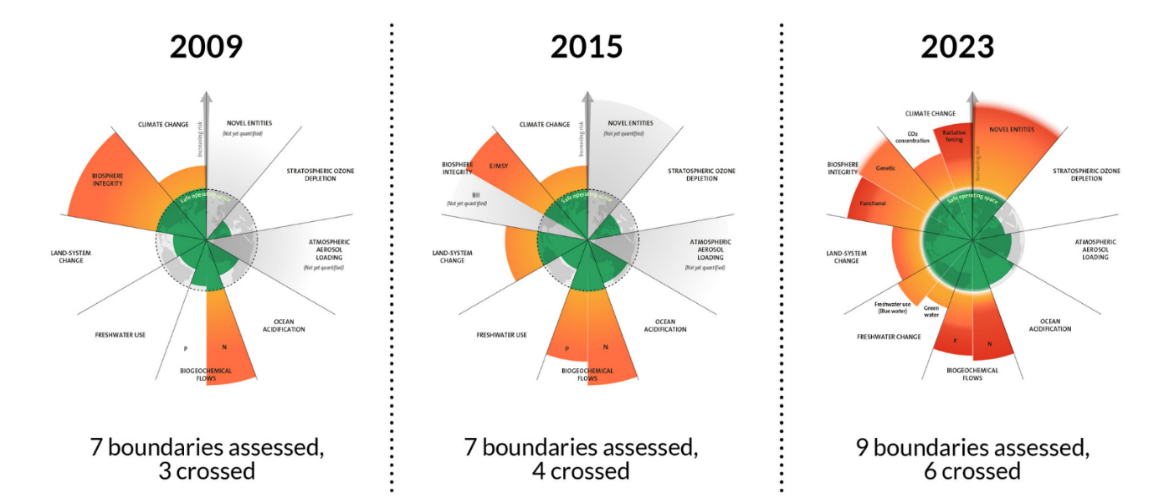
Source: Stockholm Resilience Center
Essentially, these parameters in planetary boundaries contribute to the biggest threats of Earth’s biodiversity, such as the land system change, climate change, Anthropocene interference in the biogeochemical flows of nature through chemical pollution, ocean acidification, and global freshwater overexploitation. According to the World Wildlife Fund (WWF), the diversity of life on earth has decreased significantly over the past few decades, and following are the biggest threats to Earth’s biodiversity:
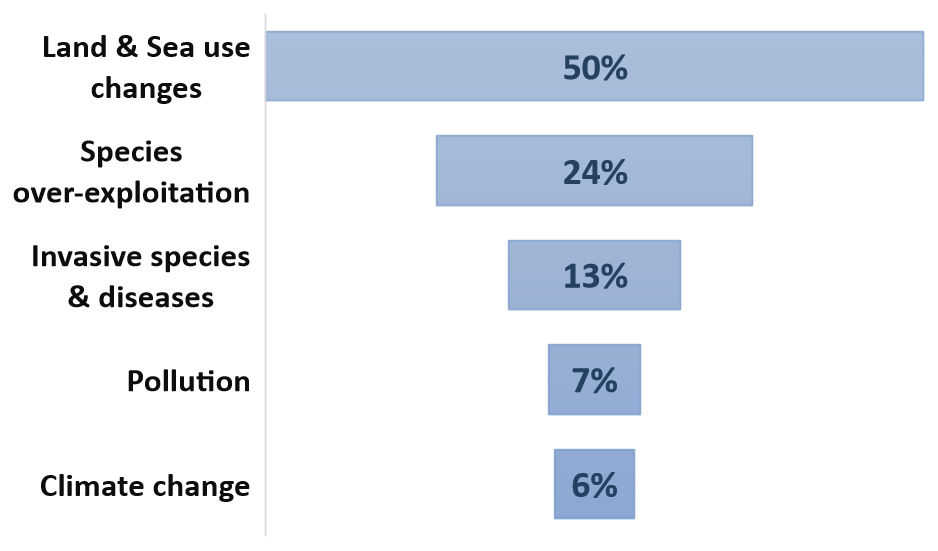
Source: WWF
Biodiversity loss over the last century has been significant and is primarily due to anthropogenic reasons, which have, in turn, impacted us through ecosystem services degradation, health implications owing to loss of resilience to diseases and to extreme weather conditions, and the economic impact, particularly in communities that directly depend on natural resources.
As an indicator, the 2024 Living Planet Index (LPI) update for Migratory Freshwater Fishes unveils a startling 81 percent decline in monitored populations of freshwater migratory fishes from 1970 to 2020.
Organizations leading the charge in conservation efforts
Regarding the protection of biodiversity and the conservation of nature, organizations such as World Wildlife Fund (WWF), International Union for Conservation of Nature (IUCN), Wildlife Conservation Society (WCS), Fauna & Flora International, and Conservation International (CI) support various research projects, welfare schemes and conservation projects all over the world, while also assisting at the intergovernmental level to formulate various treaties between nations.
It is not the responsibility only of these global guardians to protect biodiversity, but that responsibility lies with each one of us and our businesses to seek ways to maintain the ecological balance and promote our overall well-being.
The need for a greener ledger
Nature is now a strategic risk management issue– the accelerating biodiversity loss is increasing the exposure of physical and transition risks to businesses as well as humans. Thus, understanding the ecological impacts of a business can safeguard it against future regulatory, reputational, operational and climatic risks.
Biodiversity, if integrated into financial decision-making of business thinking, will help companies recognize the financial implications of their impacts and their dependencies on the environment. This recognition is crucial in steering the global economy towards sustainability and resilience, acknowledging the indispensable value of biodiversity in maintaining the health of the planet and the well-being of human societies. It will play a significant role in helping to tackle environmental and biodiversity loss, thus helping in the transition towards an environment-positive future. The Task Force on Nature-related Financial Disclosures (TNFD), which offers a framework for businesses to examine just this, is pioneering efforts to make nature an integral part of financial reporting.
TNFD explains how a business contributes towards sustaining the very ecosystem that sustains it:
- By recognizing the impacts and dependencies of the business on the environment.
- By aligning the business strategies and governance structure with ecological goals.
- By assessing the risks and opportunities from nature-related dependencies.
- By monitoring the impacts (both positive & negative) through assessment of key metrics and targets integrated with material nature-related dependencies.
GRESB Assessments – integrating biodiversity into real estate sustainability
The Global Real Estate Sustainability Benchmark (GRESB) framework includes several key indicators and metrics that address biodiversity conservation as distinct from other material issues. Some of the key indicators related to biodiversity conservation within the GRESB framework are:
- Presence of policy on environmental issues like biodiversity and habitat.
- Addressing biodiversity and habitat in the ESG strategy during development of RE assets.
- Assessment of risks (environmental and social) as part of due diligence on the operational RE assets on parameters such as biodiversity and habitat.
GRESB not only considers biodiversity directly through the above three factors, it also integrates the requirement of sustainable land use through biodiversity-centric site selection criteria in RE developments, since land use change is the largest contributor to the loss of biodiversity.
Bending the curve upwards on biodiversity loss
As per the Living Planet Report 2022, scenario-based modeling is increasingly mobilized at the science-policy interface to identify plausible futures. It highlights the need to tackle human drivers (both direct and indirect) as a clear element of the transformative change needed to enable deliberate action in moving from the current status quo scenarios with least actions (grey line) to a nature-positive society with integrated action portfolios (yellow line), via transition scenarios with transformative change driven by increased conservation efforts (green line).
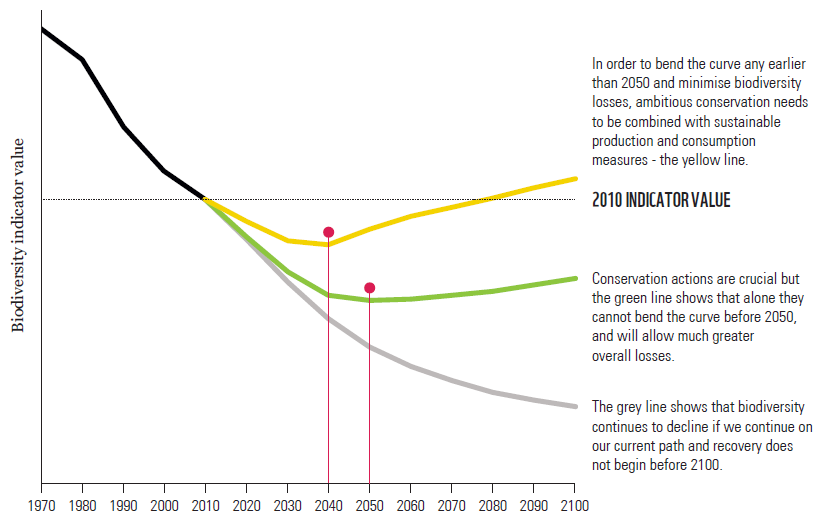
Source: WWF
Understanding the distinct demarcation between “what is to be sustained and what is to be developed” helps businesses, communities, and nations approach sustainable development not as a destination, but as an ongoing, adaptive learning process towards achieving the UN SDGs for overall well-being.
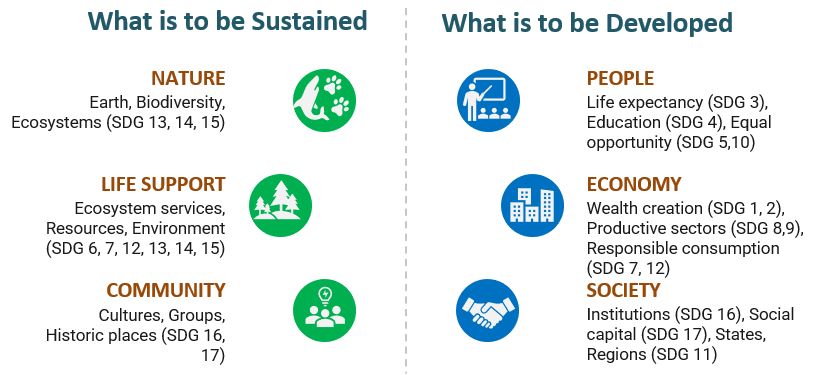
Source: National Academies Press
Exploring safe operating space for humanity by unveiling The Matrix
The variety and variability of life forms within an ecosystem ensure its resilience and ability to adapt to changes or abrupt shocks. Thus, preserving biodiversity is essential not only for maintaining ecological balance, but also for sustaining the ecosystem services that support human well-being and economic stability.
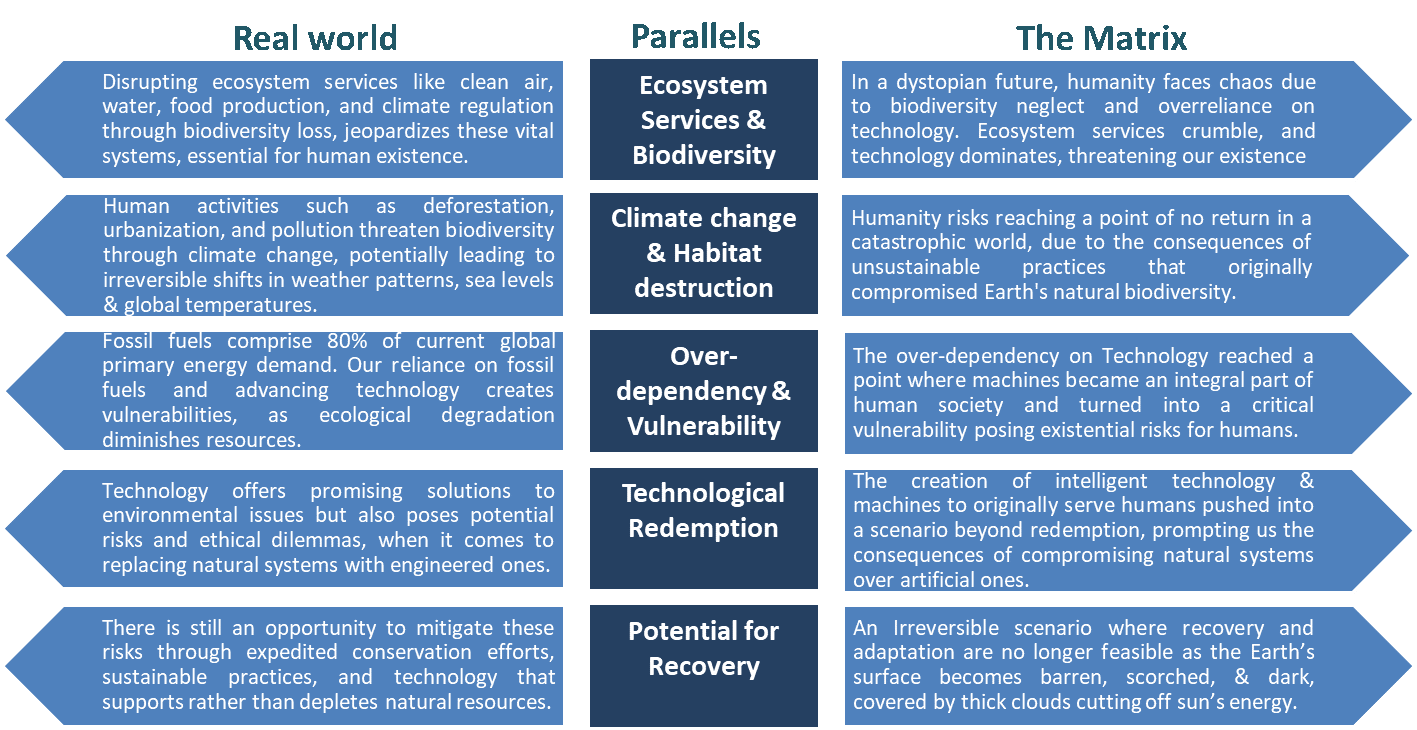
With the rate at which we are exploiting resources, through the compromise of biodiversity coupled with the advancements of technology, we are not very far away from making “The Matrix” a reality. That is, of course, unless we change our thoughts and actions!
This article was written by Swasthi Krithivasan, Head of ESG at Conserve Consultants Pvt. Ltd.
References:
“Planetary boundaries.” Stockholm Resilience Center. Accessed July 1, 2024.
Rockström, Johan, Will Steffen, Kevin Noone, Åsa Persson, F. Stuart III Chapin, Eric Lambin, Timothy Lenton, et al. “Planetary Boundaries: Exploring the Safe Operating Space for Humanity.” Ecology and Society. Accessed July 1, 2024.
Ang, Carmen. “WWF: These are the biggest threats to the Earth’s biodiversity.” World Economic Forum. Accessed July 1, 2024.
“2024 Living Planet Index Update for Migratory Freshwater Fishes.” World Wildlife Fund. Accessed July 1, 2024.
Taskforce on Nature-related Financial Disclosures. Accessed July 1, 2024.
“Recommendations of the TNFD.” Taskforce on Nature-related Financial Disclosures. Accessed July 1, 2024.
“Living Planet Report.” World Wildlife Fund. Accessed July 1, 2024.
“Our Common Journey: A Transition toward Sustainability.” The National Academies Press. Accessed July 1, 2024.


